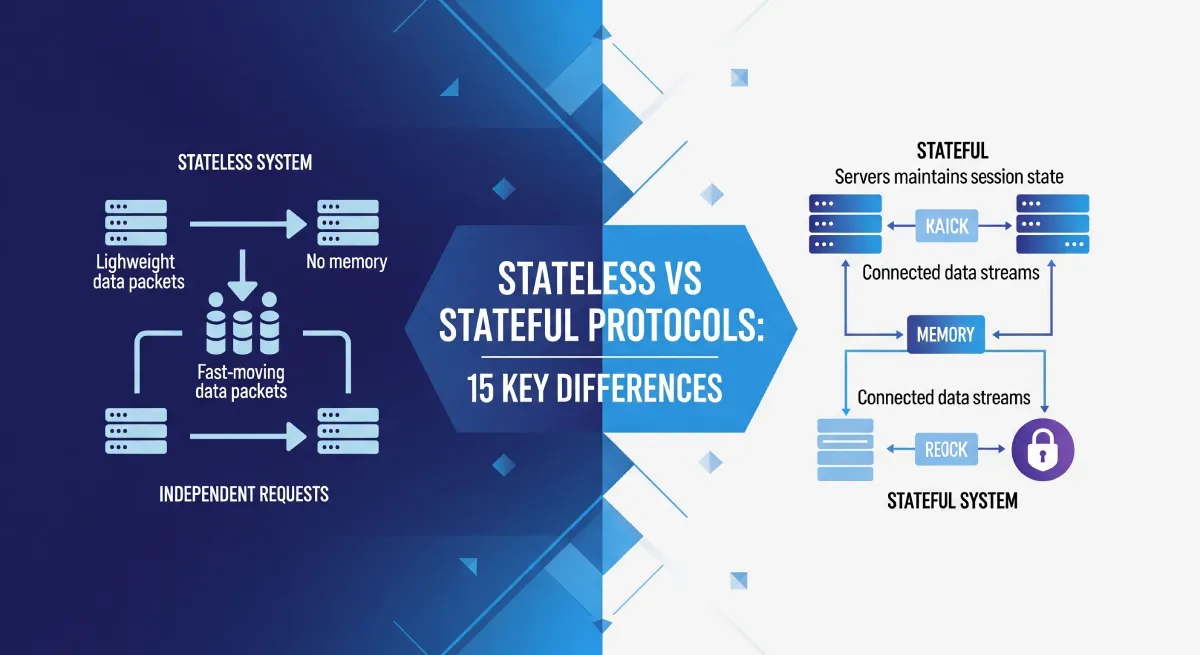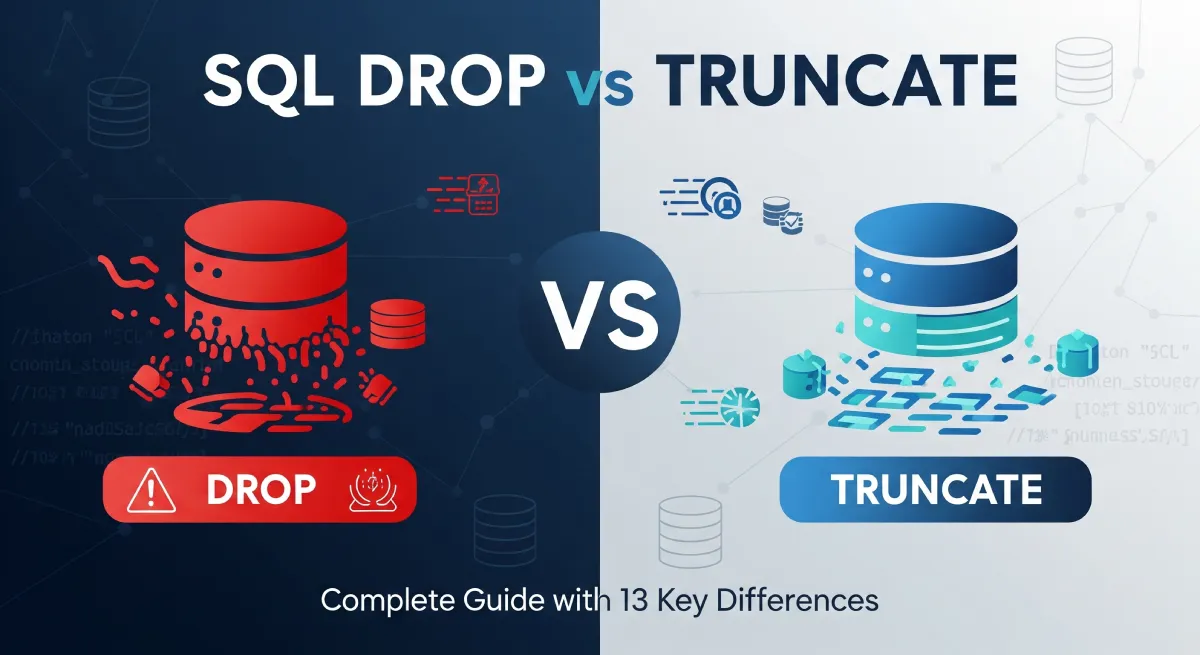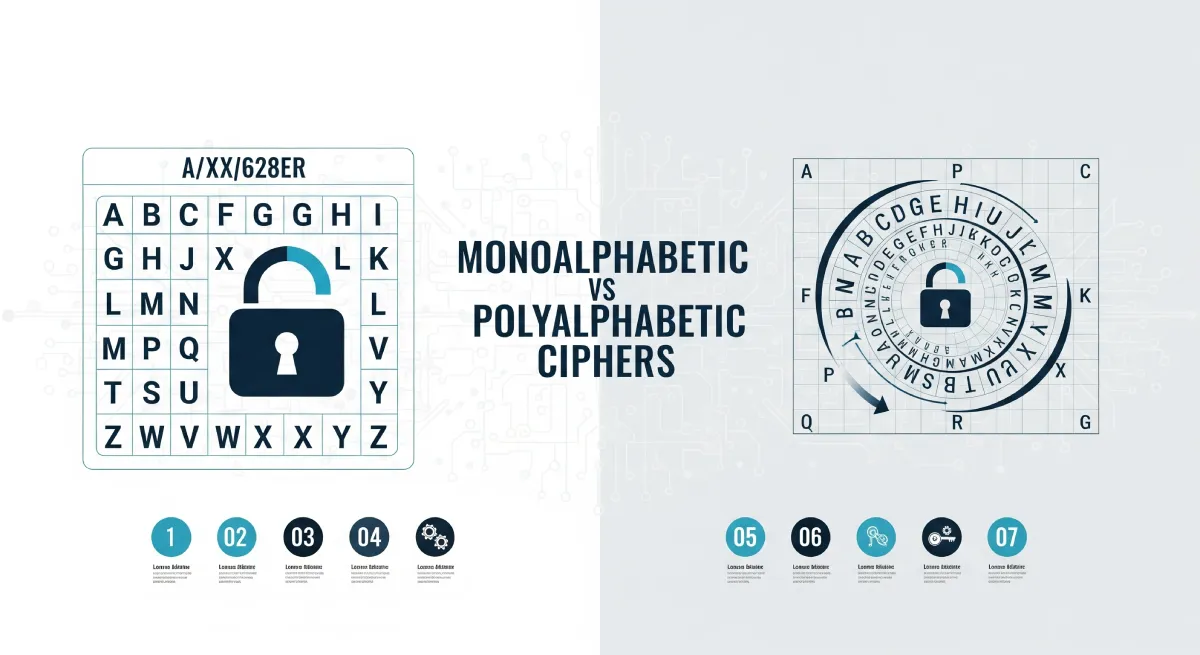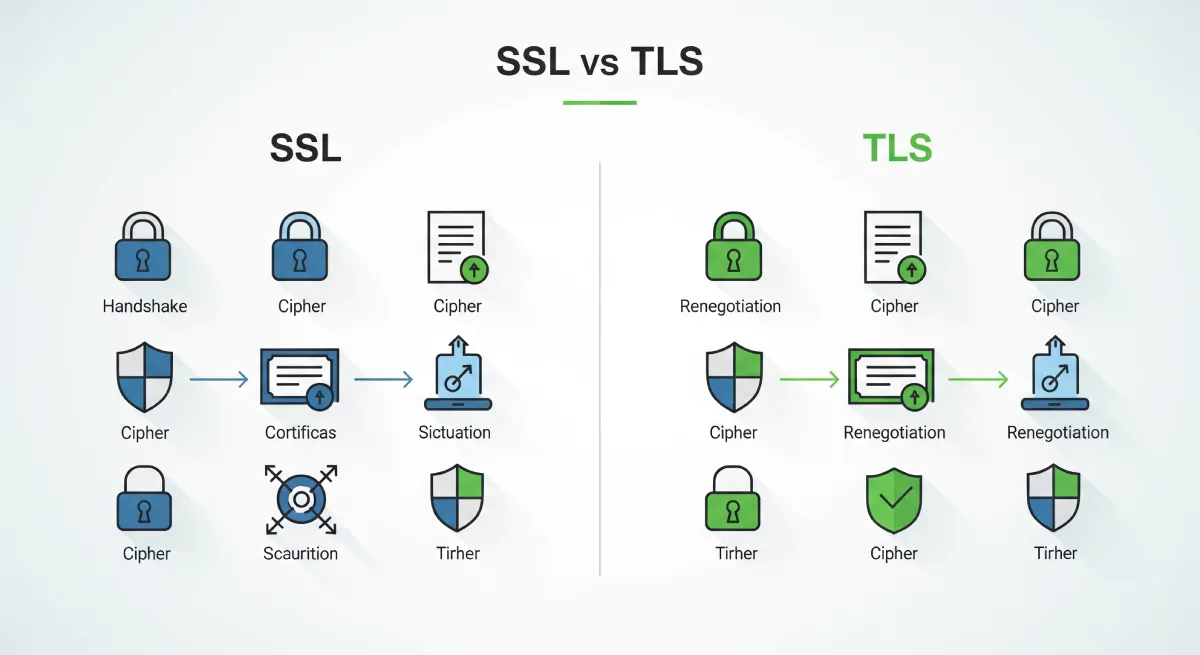Understanding Cipher Types in Modern Cryptography
Encryption forms the backbone of digital security, protecting everything from personal messages to financial transactions. At the heart of classical cryptography lie two fundamental approaches: monoalphabetic and polyalphabetic ciphers.
Understanding these concepts is crucial for anyone entering the field of cybersecurity or cryptography.
While modern encryption has evolved significantly, these classical ciphers remain relevant for educational purposes and provide the foundation for understanding more complex encryption methods used today.
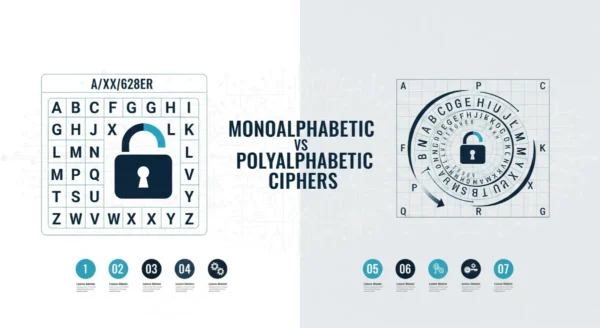
Monoalphabetic Ciphers: The Foundation of Substitution Encryption
Monoalphabetic ciphers represent the simplest form of substitution encryption, where each letter in the plaintext is consistently replaced with the same letter or symbol throughout the entire message. This one-to-one mapping creates a fixed
relationship between plaintext and ciphertext characters.
Advantages
- ✓ Simple to understand and implement
- ✓ Requires minimal computational resources
- ✓ Perfect for educational purposes
- ✓ Fast encryption and decryption process
Disadvantages
- ✗ Highly vulnerable to frequency analysis
- ✗ Limited key strength due to fixed substitution
- ✗ Easy to crack with statistical methods
- ✗ Not suitable for secure communications
Technical Characteristics
- Single substitution key: Uses one fixed alphabet mapping
- Consistent mapping: Each letter maps to the same replacement every time
- Preserved patterns: Letter frequency patterns remain visible
- Simple key space: Limited number of possible keys
Common Use Cases
Monoalphabetic ciphers are primarily used for educational purposes, introductory cryptography courses, puzzle games, and historical encryption demonstrations. They’re not recommended for any real-world security applications.
Polyalphabetic Ciphers: Enhanced Security Through Multiple Alphabets
Polyalphabetic ciphers revolutionized classical cryptography by employing multiple substitution alphabets during the encryption process. This approach significantly enhances security by varying the substitution pattern based on the position
of letters in the plaintext.
repeats.
Advantages
- ✓ Superior security vs. monoalphabetic ciphers
- ✓ Resistant to frequency analysis attacks
- ✓ Variable encryption patterns
- ✓ More complex cryptanalysis required
Disadvantages
- ✗ Complex key management requirements
- ✗ Slower encryption/decryption process
- ✗ Vulnerable to keyword analysis if key is weak
- ✗ Requires more computational resources
Technical Characteristics
- Multiple substitution keys: Uses several different alphabet mappings
- Position-dependent encryption: Same letter encrypted differently based on position
- Pattern disruption: Breaks up frequency patterns in the ciphertext
- Keyword-based variation: Encryption changes based on key sequence
Modern Applications
While not used for modern secure communications, polyalphabetic ciphers are valuable in advanced cryptography education, historical cipher analysis, cryptographic puzzles, and as stepping stones to understanding modern encryption
algorithms.
7 Key Differences: Monoalphabetic vs Polyalphabetic Ciphers Detailed Analysis
Aspect | Monoalphabetic Cipher | Polyalphabetic Cipher |
|---|---|---|
| 1. Substitution Method | Uses a single fixed substitution alphabet for entire message | Uses multiple substitution alphabets that change during encryption |
| 2. Security Level | Vulnerable to frequency analysis due to consistent letter substitutions | More resistant to frequency analysis as letter substitutions vary |
| 3. Implementation Complexity | Simple to implement and understand – beginner friendly | Complex to implement and requires understanding of key patterns |
| 4. Encryption Pattern | Each letter always encrypted with the same corresponding letter | Same letters encrypted differently based on position in message |
| 5. Attack Resistance | Subject to cracking using basic statistical methods | Requires advanced cryptanalysis techniques to break |
| 6. Performance Speed | Generally faster to encrypt and decrypt due to simple process | Slower due to complex algorithms and multiple key operations |
| 7. Key Management | Simple key management – single substitution table | Complex key management – multiple keys or keyword patterns |
| 8. Brute Force Resistance | Can be broken with relatively simple brute force attacks | Requires significantly more computational effort for brute force |
| 9. Decryption Process | Straightforward reversal of single substitution pattern | Complex process requiring understanding of multiple key patterns |
| 10. Historical Usage | Classic ciphers like Caesar cipher, Atbash cipher | Advanced systems like Vigenère cipher, Enigma machine |
Security Comparison: Why Polyalphabetic Wins
Monoalphabetic Vulnerabilities
- Frequency Analysis: Letter patterns remain visible
- Statistical Attacks: Easy to analyze with basic tools
- Pattern Recognition: Common words easily identifiable
- Brute Force: Limited key space makes exhaustive search feasible
- Automated Cracking: Modern computers can break these instantly
Polyalphabetic Strengths
- Frequency Disruption: Breaks up letter frequency patterns
- Complex Analysis: Requires advanced cryptanalysis techniques
- Variable Patterns: Same letters produce different ciphertext
- Larger Key Space: More possible key combinations
- Historical Significance: Used in military communications for centuries
Practical Implementation Guide
Step-by-Step Implementation Process
- Choose your cipher type: Decide between monoalphabetic or polyalphabetic based on your learning objectives
- Design the key structure: Create a single substitution table (mono) or keyword pattern (poly)
- Implement encryption logic: Write functions to substitute characters according to your chosen method
- Create decryption functions: Develop reverse processes to recover original text
- Test thoroughly: Validate your implementation with various test cases
- Handle edge cases: Ensure proper handling of spaces, punctuation, and special characters
Monoalphabetic Cipher Implementation
Here’s a simple implementation of a monoalphabetic cipher using Python:
def monoalphabetic_encrypt(text, key):
"""
Encrypt text using monoalphabetic substitution
key: list of 26 characters representing the cipher alphabet
"""
encrypted_text = ""
for char in text:
if char.isalpha():
# Convert to uppercase and get position
pos = ord(char.upper()) - ord('A')
encrypted_text += key[pos]
else:
encrypted_text += char
return encrypted_text
def monoalphabetic_decrypt(text, key):
"""
Decrypt text using monoalphabetic substitution
"""
decrypted_text = ""
for char in text:
if char.isalpha():
# Find position in cipher alphabet
pos = key.index(char.upper())
decrypted_text += chr(pos + ord('A'))
else:
decrypted_text += char
return decrypted_text
# Example usage
key = ['B', 'A', 'D', 'C', 'E', 'F', 'G', 'H', 'I', 'J', 'K', 'L', 'M',
'N', 'O', 'P', 'Q', 'R', 'S', 'T', 'U', 'V', 'W', 'X', 'Y', 'Z']
plain_text = "HELLO WORLD"
encrypted = monoalphabetic_encrypt(plain_text, key)
decrypted = monoalphabetic_decrypt(encrypted, key)
print(f"Original: {plain_text}")
print(f"Encrypted: {encrypted}")
print(f"Decrypted: {decrypted}")
Polyalphabetic Cipher Implementation
Here’s an implementation of the famous Vigenère cipher:
def vigenere_encrypt(plain_text, key):
"""
Encrypt text using Vigenère cipher
key: keyword string
"""
encrypted_text = ""
key_length = len(key)
key_index = 0
for char in plain_text:
if char.isalpha():
# Get the key character for this position
key_char = key[key_index % key_length]
shift = ord(key_char.upper()) - ord('A')
# Encrypt the character
if char.isupper():
encrypted_char = chr((ord(char) - ord('A') + shift) % 26 + ord('A'))
else:
encrypted_char = chr((ord(char.upper()) - ord('A') + shift) % 26 + ord('A'))
encrypted_text += encrypted_char
key_index += 1
else:
encrypted_text += char
return encrypted_text
def vigenere_decrypt(encrypted_text, key):
"""
Decrypt text using Vigenère cipher
"""
decrypted_text = ""
key_length = len(key)
key_index = 0
for char in encrypted_text:
if char.isalpha():
# Get the key character for this position
key_char = key[key_index % key_length]
shift = ord(key_char.upper()) - ord('A')
# Decrypt the character
decrypted_char = chr((ord(char.upper()) - ord('A') - shift) % 26 + ord('A'))
decrypted_text += decrypted_char
key_index += 1
else:
decrypted_text += char
return decrypted_text
# Example usage
key = "CRYPTOGRAPHY"
plain_text = "HELLO WORLD"
encrypted = vigenere_encrypt(plain_text, key)
decrypted = vigenere_decrypt(encrypted, key)
print(f"Original: {plain_text}")
print(f"Key: {key}")
print(f"Encrypted: {encrypted}")
print(f"Decrypted: {decrypted}")
Best Practices and Optimization Tips
Security Best Practices
- Use strong, random keys for better encryption
- Ensure keys are at least as long as the message (for perfect security)
- Avoid predictable patterns in polyalphabetic keys
- Never reuse keys for different messages
Implementation Tips
- Include comprehensive error handling
- Optimize for performance with large texts
- Use built-in library functions where possible
- Implement proper input validation
Common Pitfalls and Solutions
Solution: Generate strong, random keys using cryptographically secure random number generators. For educational purposes, ensure keys are sufficiently long and unpredictable.
Solution: Implement comprehensive character handling that preserves formatting while only encrypting alphabetic characters. Include proper case handling logic.
Solution: Carefully implement modular arithmetic operations, especially for negative numbers in decryption. Test thoroughly with edge cases.
Real-World Historical Examples
Caesar Cipher (Monoalphabetic)
Used by Julius Caesar for military communications. Simple shift cipher where each letter is shifted by a fixed number of positions.
Historical Impact: Effective for its time but easily broken today.
Vigenère Cipher (Polyalphabetic)
Known as “le chiffre indéchiffrable” (the indecipherable cipher) for 300 years. Used extensively in diplomatic and military communications.
Historical Impact: Considered unbreakable until frequency analysis techniques were developed.
Enigma Machine (Advanced Polyalphabetic)
Used by Nazi Germany during WWII. Electromechanical rotor cipher machine that implemented a complex polyalphabetic substitution.
Historical Impact: Breaking Enigma was crucial to Allied victory in WWII.
Frequently Asked Questions
This fundamental difference significantly affects both the complexity and security of the encryption algorithm.
polyalphabetic ciphers provide better resistance to cryptanalysis due to their use of multiple substitution alphabets. For modern applications, use AES, RSA, or other contemporary encryption standards.
shift (24), then the pattern repeats. This creates multiple substitution alphabets, making it much harder to break than simple monoalphabetic ciphers.
patterns. However, if the keyword is too short relative to the message length, patterns may emerge that cryptanalysts can exploit.
vulnerable to techniques like Kasiski examination and modern computational attacks. This is why these ciphers are now used only for educational purposes.
understand the evolution of cryptography and the importance of modern encryption methods.
Conclusion & Recommendations
The comparison between Monoalphabetic vs Polyalphabetic Ciphers reveals fundamental differences in complexity, security, and practical applications. While monoalphabetic ciphers offer simplicity and ease of implementation, they fall short in providing adequate security due to their vulnerability to frequency analysis and statistical attacks.
Monoalphabetic vs Polyalphabetic Ciphers also highlight a clear evolution in classical encryption methods. Polyalphabetic ciphers, with their use of multiple substitution alphabets, represent a significant advancement in classical cryptography. They provide enhanced security through pattern disruption and increased complexity, making them more resistant to traditional cryptanalytic techniques.
Key Takeaways
- Polyalphabetic ciphers are significantly more secure than monoalphabetic ones
- Both types are obsolete for modern security applications
- Understanding these ciphers is crucial for cryptographic education
- They demonstrate the evolution from simple to complex encryption methods
Quick Decision Guide
For Learning:
Start with monoalphabetic ciphers to understand basic concepts, then progress to polyalphabetic for advanced learning.
For Security:
Use modern encryption standards like AES-256, RSA, or elliptic curve cryptography.
For Historical Interest:
Study both types to understand the evolution of cryptographic techniques.
Final Recommendations
When choosing between these cipher types for educational purposes, consider the following decision-making criteria:
- Learning Objectives: Use monoalphabetic for basic understanding, polyalphabetic for advanced concepts
- Security Requirements: Neither is suitable for real-world security applications
- Computational Resources: Consider processing power and time constraints
- Historical Context: Both types provide valuable insights into cryptographic evolution
Understanding these classical ciphers provides a solid foundation for comprehending modern cryptographic principles and appreciating the sophisticated security measures that protect our digital communications today.
